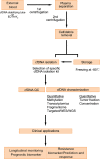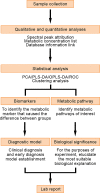The Role of Liquid Biopsy Analytes in Diagnosis, Treatment and Prognosis of Colorectal Cancer
- PMID: 35846270
- PMCID: PMC9279561
- DOI: 10.3389/fendo.2022.875442
The Role of Liquid Biopsy Analytes in Diagnosis, Treatment and Prognosis of Colorectal Cancer
Abstract
Colorectal cancer (CRC) is one of the most common malignant tumors of the digestive tract worldwide and is a serious threat to human life and health. CRC occurs and develops in a multi-step, multi-stage, and multi-gene process, in which abnormal gene expression plays an important role. CRC is currently diagnosed via endoscopy combined with tissue biopsy. Compared with tissue biopsy, liquid biopsy technology has received increasingly more attention and applications in the field of molecular detection due to its non-invasive, safe, comprehensive, and real-time dynamic nature. This review article discusses the application and limitations of current liquid biopsy analytes in the diagnosis, treatment, and prognosis of CRC, as well as directions for their future development.
Keywords: circulating tumor DNA; circulating tumor cell; circulating tumor miRNA; colorectal cancer; exosomes.
Copyright © 2022 He, Xi, Han, Luo, Shen, Wang, Li, Guo and Cheng.
Conflict of interest statement
The authors declare that the research was conducted in the absence of any commercial or financial relationships that could be construed as a potential conflict of interest.
Figures





References
-
- GBD 2017 Colorectal Cancer Collaborators . The Global, Regional,and National Burden of Colorectal Cancer and Its Attributable Risk Factors in 195 Countries and Territories, 1990-2017:a Systematic Analysis for the Global Burden of Disease Study. Lancet Gastroenterol Hepatol (2019) 4(12):913–33. doi: 10.1016/S2468-1253(19)30345-0 - DOI - PMC - PubMed
-
- Sharp L, O'Leary E, O'Ceilleachair A, Skally M, Hanly P. Financial Impact of Colorectal Cancer and Its Consequences: Associations Between Cancer-Related Financial Stress and Strain and Health-Related Quality of Life. Dis Colon Rectum (2018) 61(1):27–35. doi: 10.1097/DCR.0000000000000923 - DOI - PubMed
Publication types
MeSH terms
Substances
LinkOut - more resources
Full Text Sources
Medical

